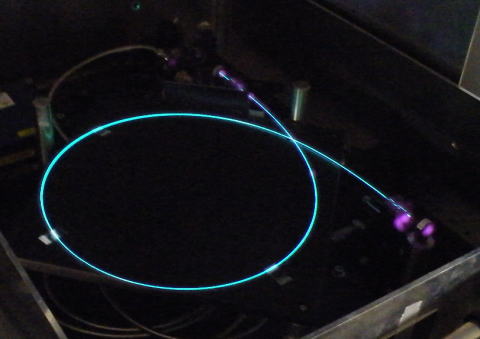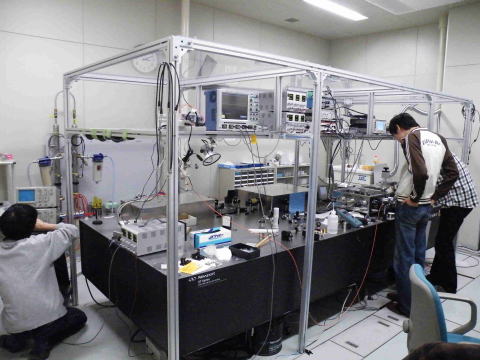Research
we are interested in an ultrafast lasers and their applications.
The laser was invented in 1960, and has been developed for more than 50
years. Ultra-narrow-linewidth lasers were used for precision measurement,
and applied for physics with cold atoms. On the other hand, Ultra-broad-band
lasers, which corresponds to the ultra-short pulse lasers were applied
for the investigation of the dynamics of the ions or electrons. These two research area were studied independently since the demanded technologies were different.
In 2000, an "Optical frequency comb" was invented, and the situation changed a lot.
The mode-locked femtosecondn laser contains 100 thousand longitudinal modes in its spectrum, and there are only two degrees of freedom, offset frequency and the mode spacing (repetition frequency).
These two parameters were locked in 2000, then each comb tooth can be worked as a cw laser. Then the femtosecond laser works as 100 thousand cw lasers!
This technology corresponds to the carrier-envelope-phase control in a time domain, and it produced an attosecond science.
The optical frequency combs can be applied for variaty of application area.
An optical atomic clock is one of the most important application. The optical frequency combs works as a gear from the optical frequency (300THz) to an Rf frequency (100MHz).
Second is an astronomical application. The frequency combs works as a frequency ruler in optical frequency. The spectrum obtained by a telescope can be superimposed with the comb, then the doppler shift of the star light can be observed very precisely.
An extrasolar planet could be found by using this technology. Or one could measure the speed of expansion of the universe precisely.
The multiple-wavelength precision spectroscopy in the mid-infrared would be helpful to detect a trace gas, which would be applied for atomosphere sensing or breath diagnostic.
We are collaborating with MPQ in Germany, NIST in USA, and KAIST in KOREA
- High-repetition-rate Yb-doped fiber laser system
- 80 MHz, 200 fs, 45 W CPA laser was developed. it was injected to an enhancement cavity, and high-order harmonics were generated. The intra power is more than 3 kW.

- XUV freqeuncy comb by unsing high-order harmonics.
- We have generated XUV comb to 54 nm.

- Photo-electron spectroscopy pumped by a coherent VUV lihgt.
- We have developed 153-nm coherent light for ARPES.
- High-field physics at high repetition rate
- Optical frequency comb
- We are developing an optical frequency comb by using Yb:fiber laser. Yb comb would have both long and short term stabilities, that are separately realised by Er:fiber and Ti:sapphire combs.

- Dual-comb spectroscopy
- precition specroscopy of atoms or molecules
experimental setup

- femtosecond Yb-fiber oscillator
- Mode-locked fiber oscillators generate ~30-fs pulse trains. We have at least 14, hand-made oscillators in our lab.


- Yb-fiber amplifiers
- A lot of Yb-fiber amplifiers were developed. Up to 60-W average power is obtained by 200-W pump power. The high-efficiency transmission gratings are used for the pulse compressor so that 45-W, femtosecond pulse train is generated with 80-MHz repetition rate. We have also constructed a 10-MHz CPA system, which generates 23-W average power. We also have a lot of small-power amplifiers for various applications such as an optical frequency comb.We have at leaset 17 fiber amplifiers in our lab.
- Enhancement cavity for high-harmonic generation
- An enhancement cavity is used for higher avearage power generation for high-rep-rate high-harmonic generation. We have built 80-MHz and 10-MHz enehancement cavities. 10-MHz caivity has 30-m long cavity in a vaccume, which is nice looking.

- laser control
- The electronic circuit is so important for the precision control of the laser systems. We have many setups to make our designed special circuits.
- picosecond laser system
- 30-ps, high-power laser system is used for coherent light generation at 153 nm by using KBBF crystal. This wavelength is the shortest, to our vest knowledge, in the pahse-matched sum-freqeuncy generation.

- solid-state lasers
- We are studing about very high repetition-rate mode-locked lasers for comb applications such as astronomical or medical applications. Up to 6-GHz rep rate is obtained pumping by a laser diode directly.
- Others
- The member here has to make one's own femtosecond laser at first for the training.
